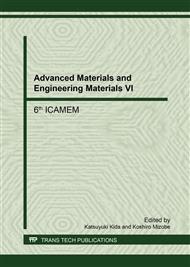p.132
p.137
p.143
p.148
p.155
p.160
p.166
p.173
p.181
Effect of Preparation on Microstructure of Ag-Loaded TiO2 Nanotube Arrays
Abstract:
We have synthesyzed TiO2 nanotubes by an anodization method. The cathode was titanium (Ti) sheets and anode was platinum (Pt). The electrolytes were mixtures of ethylene glycol (EG), ammonium fluoride (NH4F) and deionized water (DI water). The anodizing voltage was set to 50 V and the process was carried out for 2 h. The titanium foils were anodized at room temperature. Then Ag nanoparticles were loaded in TiO2 nanotube arrays by immersed in 50 ml solutions containing of AgNO3 (1.0, 1.5 and 2.0 mM) for 24 h. The morphology, structure, and optical properties of the prepared nanotubes were characterized by X-ray diffraction (XRD), scanning electron microscopy (SEM) and and UV-vis spectroscopy (UV-vis) respectively. The structures of TiO2 nanotubes obtained from the nanotube arrays were crystallized by annealing at 450 °C for 2 h before immersed in solution and immersed in solution before crystallized by annealing are similar. When the concentration of silver nitrate (AgNO3) increases, the TiO2 nanotube arrays cracked and are not well arranged.
Info:
Periodical:
Pages:
155-159
Citation:
Online since:
August 2017
Authors:
Keywords:
Price:
Сopyright:
© 2017 Trans Tech Publications Ltd. All Rights Reserved
Share:
Citation:


